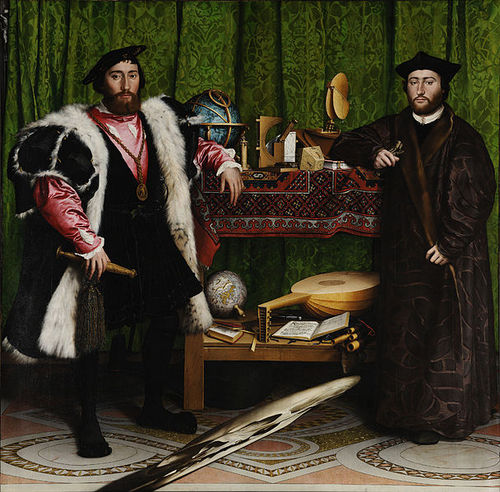Watching "Fact or Faked: Paranormal Files" (one of my favotire tv shows) the other day, I heard a word I didn't know: anamorphosis. It helped the researchers in the show to recreate a human silhouette in a couple of wooden boxes, resembling a ghost in a picture. So here's how it works!
Anamorphosis is defined as a distorted projection or perspective requiring the viewer to use special devices or occupy a specific vantage point to reconstitute the image. The word "anamorphosis" is derived from the Greek prefix ana-, meaning back or again, and the word morphe, meaning shape or form.
There are two main types of anamorphosis: perspective (oblique) and mirror (catoptric). Examples of perspectival anamorphosis date to the early Renaissance (fifteenth century), but examples of mirror anamorphosis were first created in the late Renaissance (sixteenth century). With mirror anamorphosis, a conical or cylindrical mirror is placed on the drawing or painting to transform a flat distorted image into a three-dimensional picture that can be viewed from many angles. The deformed image is painted on a plane surface surrounding the mirror. By looking uniquely into the mirror, the image appears undeformed. This process of anamorphosis made it possible to diffuse caricatures, erotic and scatological scenes and scenes of sorcery for a confidential public.
Cinemascope, Panavision, Technirama and other widescreen formats use anamorphosis to project a wider image from a narrower film frame. The system of anamorphic projection can be seen quite commonly on text written at a very flat angle on roadways, such as "Bus Lane" or "Children Crossing", which is easily read by drivers who otherwise would have difficulty reading as the vehicle approaches the text; when the vehicle is nearly above the text, its true abnormally elongated shape can be seen. Similarly, in many sporting stadiums, especially in Rugby football in Australia and Soccer in Brazil, it is used to promote company brands which are painted onto the playing surface; from the television camera angle, the writing appear as signs standing vertically within the field of play. Even on some 0.5 liter Sprite bottles in Europe, an extra "bar code" was present. When the bottle is tilted towards the mouth while drinking, the bar code resolves into writing due to the anamorphic effect. Finally, much writing on shop windows is in origin anamorphic, as it was written mirror-reversed on the inside of the window glass.
Anamorphosis is defined as a distorted projection or perspective requiring the viewer to use special devices or occupy a specific vantage point to reconstitute the image. The word "anamorphosis" is derived from the Greek prefix ana-, meaning back or again, and the word morphe, meaning shape or form.
There are two main types of anamorphosis: perspective (oblique) and mirror (catoptric). Examples of perspectival anamorphosis date to the early Renaissance (fifteenth century), but examples of mirror anamorphosis were first created in the late Renaissance (sixteenth century). With mirror anamorphosis, a conical or cylindrical mirror is placed on the drawing or painting to transform a flat distorted image into a three-dimensional picture that can be viewed from many angles. The deformed image is painted on a plane surface surrounding the mirror. By looking uniquely into the mirror, the image appears undeformed. This process of anamorphosis made it possible to diffuse caricatures, erotic and scatological scenes and scenes of sorcery for a confidential public.
Cinemascope, Panavision, Technirama and other widescreen formats use anamorphosis to project a wider image from a narrower film frame. The system of anamorphic projection can be seen quite commonly on text written at a very flat angle on roadways, such as "Bus Lane" or "Children Crossing", which is easily read by drivers who otherwise would have difficulty reading as the vehicle approaches the text; when the vehicle is nearly above the text, its true abnormally elongated shape can be seen. Similarly, in many sporting stadiums, especially in Rugby football in Australia and Soccer in Brazil, it is used to promote company brands which are painted onto the playing surface; from the television camera angle, the writing appear as signs standing vertically within the field of play. Even on some 0.5 liter Sprite bottles in Europe, an extra "bar code" was present. When the bottle is tilted towards the mouth while drinking, the bar code resolves into writing due to the anamorphic effect. Finally, much writing on shop windows is in origin anamorphic, as it was written mirror-reversed on the inside of the window glass.
~Ally

 RSS Feed
RSS Feed